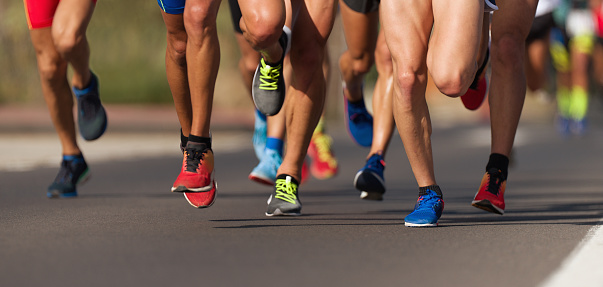


The Achilles tendon (AT) is a pretty cool tendon in our body that originates from our Soleus muscle (a giant workhorse) for running and connects with the two bellies of the Gastrocnemius (another HUGE giant workhorse) during running before inserting onto the calcaneus or heel bone. Our achilles tendon is the largest and strongest tendon in the human body as it has to withstand upwards of 12x body weight load during running!)
Given the demands placed on the AT, it’s not surprising that it’s commonly affects runners. This often manifests as a “tendinopathy,” which is an umbrella term used to describe pain and injury to the tendon typically when the current capacity of the tendon has been exceeded. Regarding tendinopathy, the tendon can progress or regress down the continuum based on the loads it is exposed to until at either ends of the spectrum we have a “rupture” or a “healthy tendon.” The most common phases we see people dealing with tendon pain are when they are in reactive , disrepair, and degeneration. With the tendon being in the reactive or disrepair phase, we can actually reverse it structurally back up the continuum towards a healthy normal tendon. However, when the tendon reaches degeneration phase or rupture, there is nothing physically we are able to do to change the actual structure of the tendon. But what we CAN do is improve the cross sectional area and collagen fibers of the SURROUNDING tendons which can ultimately improve overall tendon FUNCTION, allowing you to get back to the activities you want to be able to do pain free!
With achilles tendinopathy we have two big main types. We have mid insertional which is the main one that everyone thinks about right, right in the middle of the Achilles tendon, and we also have insertional achilles tendinopathy where we are dealing with it a bit lower where the tendon inserts on the calcaneal heel.
Because of the insertion site, compression is typically a lot more sensitive and painful in insertional achilles tendinopathy rather than mid insertional achilles tendinopathy. Compression at the achilles tendon typically occurs in end range dorsiflexion where we have the toes pointed upward. So common rehab movements in end range DF such as ankle DF stretching, as well as deficit heel raises, can actually flare up insertional achilles tendinopathy even more when you dose those in too early! So it’s super important to distinguish between the two types early on in order to know how to appropriately dose exercise and load the tendon in a meaningful manner.
When it comes to management of Achilles Tendinopathy we typically like to separate into 2 different phases. Phase 1: Calm Shit Down. Phase 2: Build Shit Back Up.
Phase 1: Calm Shit Down
· we typically want to temporarily remove stressors that aggravate and are sensitive (Typically this relates to plyometric energy storage/release movements such as jumping, hopping, running, uphill running, speed work etc.)
· manipulate different variables such as (mileage, speed, type of environment) to allow the athlete to continue training within tolerance in order to prevent deconditioning
· minimizing compression for insertional achilles tendinopathy (avoiding end range calf stretches) and maybe even putting in a heel lift to allow the heel to go into a bit of plantarflexion from neutral if it’s really aggravated.
Phase 2: Build Shit Back Up
Things such as PRP, shockwave therapy, corticosteroids, and NSAIDs all have been shown to be less effective than exercise. Tendons respond to load and so when looking to improve overall capacity of the tendon, we want to dose it with different exercise variations to the gastroc, soleus, and overall achilles complex. We can split up loading progressions into 4 different stages:
Stage 1 (Isometrics)
ex. Calf raises (hold)
Stage 2 (Isotonics - eccentrics, concentric, HSR (heavy slow resistance)
ex. Deficit Calf raises (isotonics)
Stage 3 (Energy Storage Exercises - plyometrics)
ex. Double Leg POGO hops
Stage 4 (Return to Sport)
All of these are phenomenal options in terms of finding the appropriate entry point of loading where we’re dosing enough to increase the strength of the tendon and not doing too much and overloading the tendon. Entry point of loading will vary based on where the tendon is on the continuum as well as level of sensitivity and other stressors as well.
Major Keys to Consider with Tendon Injuries
Treat the Donut - not the Hole! - Focus on improving tendon FUNCTION not structure!
Be Patient and Trust the Process! - Find a great physio who can help guide you through the process and be patient. Know that it can take up to 12 weeks for physiological adaptations and changes to occur!
Load the Tendon! - Tendon’s respond to load and in order to improve tendon capacity, we need to be loading the tendon >70% 1RM intensity to elicit appropriate adaptation.
Manipulate Different Variables to Continue Training! -Manipulate different factors such as training volume, frequency, and duration in order to continue to stay active and prevent de-conditioning!
Stay Positive and Count the Small Wins! - Managing and getting through tendinopathy injuries definitely is no easy task and it’s important to stay positive! Don’t let this one injury define who you are. Count the small wins and keep trucking along! You got this!
If you’re a runner dealing with achilles issues or heel pain, get in contact with us! We have helped hundreds of runners get back to running pain free and hit PRs in their races without any issues and we want to do the same for you!

1

0
Comments :